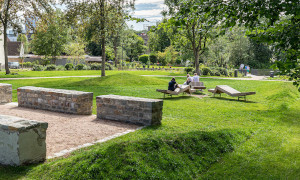By Hans Gerd Kleymann
"We have decided to end landscape architecture courses in 2030," the new Federal Education Office (a Google subsidiary) announced via Twitter. The reason given was short and sweet: "A generalist education is no longer in keeping with the times and thus finds no justification in our educational landscape."
Adieu, you green and gold times of landscape architects as saviors of nature and landscape. Welcome you environmental engineers of the subject areas climate scenarios and their effects with the specialisation heavy rain events, of the subject area plant science with the specialisation safe nutrition of bee states, the special study course micro green spaces for the population in dense urban quarters.
Generalists or specialists?
At the beginning of 2014, I was appointed from the bdla regional association of Saxony-Anhalt as a specialist spokesperson in the training working group at the bdla association. Although in our office we have often accompanied graduates at the start of their professional lives, I was not very familiar with the aim and purpose of a working group on training.
The study of landscape architecture should be as broad and cross-sectional as possible.
After four years and working group meetings at the university locations Munich, Weihenstephan, Nürtingen, Neubrandenburg and Höxter, my conclusion of the work in this committee is unreservedly positive. The commitment of the bdla and its members contributes significantly to the further development and future security of our profession and should of course be supported by further members of the regional groups. In addition to our fixed agenda items - such as exchange with the BundesFachschaftLandschaft (BuFaLa), application of the BAK guidelines on registration requirements, news from the universities, news from the associations, etc. - visits and dialogue with the professors of the respective university location take place. The junior spokespersons of the respective state association are also invited.
The exchange with the universities is very intensive and the discussion about "generalists or specialists" crystallises as a central topic. "Does nature conservation belong to landscape architecture?" is often the sticking point in the discussion. We as the training working group see the generalist as the way forward for landscape architecture.
The working group also prepares statements and position papers for the bdla national office. In 2016, for example, a position paper "Practical relevance in university education in the courses of study in landscape construction and landscape architecture" was developed together with the BGL and the BdB. Quote: "The study of landscape architecture should be as broad and cross-sectional as possible and include creative design as well as scientific-technical, planning and social, economic and ecological aspects, or develop corresponding competencies."
Who (still) wants to become a landscape architect?
This approach is certainly correct for us as a profession; but the question of how this content is communicated to the public and its effect on our young professionals must be allowed. Advertising professionals would probably talk about word monsters here.
To communicate the advantages of a generalist education to the public is the future task of our professional association.
The interest in landscape architecture, nature and plants is still strong, but competes strongly with other professions.
At our retreat in Rostock in spring 2018, we addressed the topic "How are students motivated to study landscape architecture?". From surveys conducted by various universities and associations, the following trends can be derived (in brief): Interest in landscape architecture, nature and plants remains strong, but competes strongly with other professions.
Of course, the requirements that interested students and first-year students place on the university are also important. Here, "proximity to home", "pleasant study atmosphere" and "pleasant study environment" often lead in the surveys, coupled with a "curiosity about the study content". How the students of landscape architecture and environmental planning at the Anhalt University of Applied Sciences define their studies can be experienced on YouTube.
The training working group agrees that the future of landscape architecture can only succeed if we in the bdla can present our professional image to a broad public in a concise and natural way. To this end, it would make sense to also think about a joint event with the public relations working group. May the power (and Google) be with us so that we can continue to practice our vocation as landscape architects in the distant future.
Author: Hans Gerd Kleymann, Landscape Architect bdla, Planner's Circle, Halle/Saale, spokesman for training and board member of the bdla Saxony-Anhalt. The text appeared in the bdla association magazine "Landschaftsarchitekten" 3/2019. Photo: www.pixelio.de
- Latitude: 0
- Longitude: 0


